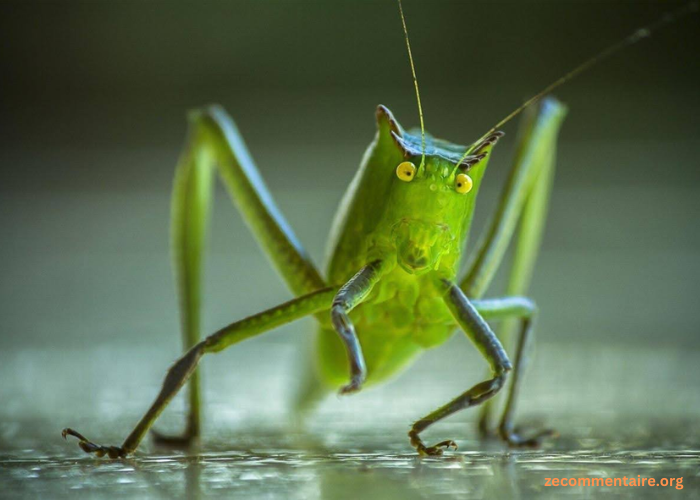When it comes to insects, there’s often confusion between similar-looking species. One such example is the mix-up between crickets and grasshoppers.
Though they might seem alike at first glance, these creatures have distinct characteristics that set them apart. Understanding these differences can enrich your appreciation of the natural world and help you identify these fascinating creatures more accurately.
In this article, we’ll delve into the difference between crickets and grasshoppers, exploring their physical traits, behaviors, habitats, and more.
An Introduction to Crickets and Grasshoppers
Crickets and grasshoppers, both belonging to the order Orthoptera, showcase a fascinating array of insect diversity. These creatures are distinguished by their remarkable hind legs, specially adapted for powerful jumping abilities.
Despite their shared classification, crickets and grasshoppers have unique traits. These traits deserve closer examination. While both insects are recognized for their signature chirping sounds, they employ different methods and purposes in creating these distinctive noises.
Crickets produce their chirps by rubbing their wings together, while grasshoppers create sounds by stridulating their legs. This nuanced difference in sound production adds to the intrigue of these captivating insects.
Let’s begin by examining some key difference between crickets and grasshoppers.
Physical Characteristics
A key difference between crickets and grasshoppers is their looks. While both insects possess elongated bodies and powerful hind legs, there are distinct features that set them apart.
Crickets typically have flat bodies. This lets them move through narrow crevices and burrows easily. Their antennae are long and slender, often exceeding the length of their bodies. Crickets are known for their distinctive chirping. They make it by rubbing their wings together in a process called stridulation.
On the other hand, grasshoppers tend to have more robust bodies with a pronounced thorax and prominent wings. Their antennae are shorter than crickets’.
They produce sound by rubbing their hind legs against their wings. This method is known as crepitating. Some grasshopper species are the largest in the world. They can grow to impressive sizes, with lengths over six inches.
Behavioral Contrasts
In addition to their physical dissimilarities, crickets and grasshoppers also exhibit contrasting behaviors. These behaviors are often linked to their respective ecological roles and habitats.
Crickets are mostly nocturnal. They prefer to stay hidden during the day. They come out at night to forage for food. They are omnivorous, feeding on a varied diet that includes plant matter, other insects, and organic debris. Crickets are also known for their solitary nature. But, some species may be gregarious at times.
Grasshoppers are diurnal insects. They are active during the day when sunlight gives them warmth and visibility. They mostly eat plants. These include leaves, grasses, and crops. Grasshoppers often stand out in their movements. They leap and fly far when threatened.
Habitat Preferences
The habitats favored by crickets and grasshoppers also differ. This reflects their distinct niches and preferences.
Crickets are common in many places. These include grasslands, forests, cities, and fields. They thrive in places with lots of plants and moisture. They use leaf litter and soil for shelter and to reproduce. Some crickets are adapted to living underground. They dig tunnels and burrows for protection from predators and bad weather.
Grasshoppers are different. They are often found in open grasslands, meadows, and farms. Their strong hind legs let them travel across vast terrain.
Their cryptic coloration camouflages them from predators. Despite living on land, some grasshoppers are good at flying. They can cover long distances to find food and good places to breed.
Reproductive Strategies
Reproduction is another aspect where crickets and grasshoppers display contrasting strategies and behaviors.
Crickets typically have a courtship ritual. They attract mates by chirping and making distinctive calls. Once a female is enticed, mating occurs, followed by the deposition of eggs in suitable substrate, such as soil or decaying organic matter. Some crickets care for their young. Females guard their eggs and nymphs until the young can fend for themselves.
Grasshoppers, however, have a less elaborate courtship ritual. They rely more on visual cues and physical displays to start mating. After copulation, females deposit eggs in the soil or plant tissue, often in clusters known as egg pods.
Grasshoppers do not care for their young. Offspring mostly depends on the environment and predators. Both crickets and grasshoppers are important in their ecosystems. They are food for other animals, pollinators for certain plants, and recycle nutrients by eating dead plant matter.
Diet and Feeding Habits
Crickets are omnivorous insects, meaning they consume both plant matter and small insects. They mainly eat leaves, grass, fruits, and seeds. But, they may also scavenge on decaying organic material or prey on small insects and larvae. Crickets are opportunistic feeders. They will eat whatever food is available in their environment.
Similarly, grasshoppers are also omnivores with a preference for plant material. They feed on a wide range of vegetation, including grasses, herbs, shrubs, and crops such as corn and wheat. Grasshoppers are well-known pests in farms. Their huge appetite can cause big crop damage if unchecked.
Fun Facts: Exploring the Quirks of Crickets and Grasshoppers
Crickets and grasshoppers are fascinating creatures with some intriguing quirks:
Largest Grasshoppers
Did you know that some species of grasshoppers are among the largest insects in the world? The largest grasshoppers are the Giant Weta, found in New Zealand, can reach lengths of up to four inches and weigh as much as a small bird!
Cricket Superstitions
In many cultures, crickets are considered symbols of good luck and prosperity. Their cheerful chirping is often linked to good omens. In some traditions, keeping a cricket in the house is believed to bring good luck.
Appreciating the Difference Between Crickets and Grasshoppers
Crickets and grasshoppers seem alike. They are both part of the Orthoptera group. But, they’ve got their quirks in looks, behaviors, homes, and reproduction. Knowing these differences makes the insect world more fascinating and helps us tell these critters apart.
Whether it’s a flat cricket or a sturdy grasshopper, each bug plays a unique role in our planet’s ecosystem. Next time you hear a chirping bug at night or see a grasshopper hopping around, take a second to appreciate how cool the difference is.
And while you’re at it, get the skinny on some interesting topics that can help you mix and mingle with your guests, visit the rest of our site now!






